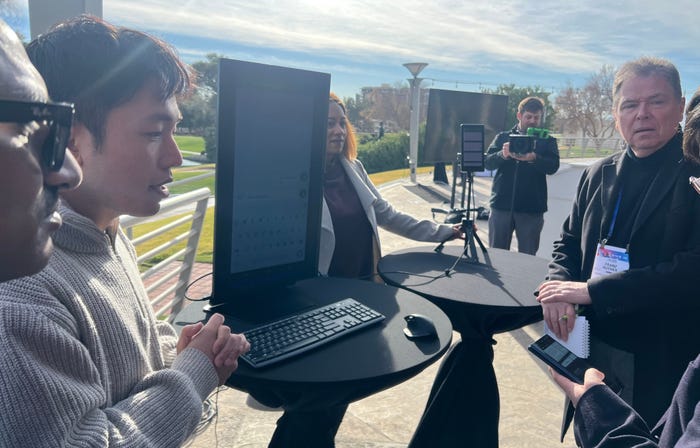Verizon launches MCPTT with Push-to-Responder offeringVerizon launches MCPTT with Push-to-Responder offering

Verizon today launched Push-to-Talk Responder, the carrier giant’s first offering that is fully compliant with the 3GPP mission-critical-push-to-talk (MCPTT) and mission-critical-data (MCData) standards when users are on the carrier giant’s network, as well as supporting interoperability with LMR systems.
“This has been something that we’ve been working on for a long time,” Nick Nilan, Verizon’s director of public-sector product development, said during an interview with IWCE’s Urgent Communications. “Finally being able to standardize push to talk on the 3GPP standard is definitely going to provide long-term support for mission-critical users, so our public-safety users can take advantage of these mission-critical services.
“This investment in our first release here is really going to be complemented with future development on more devices and more services. We’re very confident that what we’re putting into market now is really exciting and game-changing for public safety.”
Verizon’s Push-to-Talk Responder—technology provided by Ericsson—meets the 3GPP’s challenging MCPTT performance metrics for latency and call-setup when used on the nationwide Verizon LTE network, which provides quality of service, priority and preemption to qualified first-responder and secondary-responder users, according to Nilan.
“We’re really excited about the performance on the network that we’ve seen, over and above the traditional PTT devices,” he said. “[Verizon is] providing quality of service on your connection, so you’re not going to have any buffering issues, any lag or jitter. You’re getting the best possible experience for mission-critical or push-to-talk-type services on a handset, which we couldn’t ever do with push to talk as an over-the-top application.
“So, this will be the best push-to talk experience that anyone’s had.”
While MCPTT is expected to receive the most attention from the marketplace, Nilan said the initial version of Push-to-Talk Responder also supports MCData—the 3GPP standard for sending data quickly via a push-button control—but does not yet include MCVideo functionality.
“We wanted to get this out, and we felt like the video just needed a bit more testing, so that’s probably going to be pushed for a few months,” Nilan said. “What we didn’t want to do was delay the entire product set, because there are a lot of other features in mission-critical [3GPP standards] that are included in this release, in terms of voice and data services. But the video is not.”
Available immediately, Verizon’s Push-to-Talk Responder service will cost $12 per month for government/first-responder users and $15 per month for enterprise/secondary-responder users, according to a Verizon spokesperson.
“Our customers can buy the service on a direct purchase order, or we are working on getting it onto our government contracts that our customers normally buy against,” Nilan said.
“Also, secondary responders—kind of the broader set of the public-safety community that are sort of enterprise-focused, [such as] natural-gas and public utilities—are eligible for this service, as well, as long as they qualify within that secondary-responder community, and they can buy their services today.”
Users of Verizon’s MCPTT service will need to utilize approved devices that have been tested to ensure proper performance, according to Nilan.
“Really, the focus is on the ruggedized devices, the Kyocera DuraForce PRO 2 and the XP8 from Sonim,” Nilan said, noting that the Samsung S7 and S10 devices also are approved for Push-to-Talk Responder.
A key feature of Verizon’s Push-to-Talk Responder service is the ability for users to have interoperable voice communications personnel using LMR via a solution from Mutualink that meets the 3GPP’s interworking function (IWF) standard, according to Nilan.
“We use Mutualink for our gateway between the two,” Nilan said. “We created an IWF—interworking function—with Mutualink as the gateway, and it will work very well with LMR radios.
“We’ve also tested that Mutualink IWF with another carrier using mission-critical push to talk. So, we know that it works cross-carrier, also.”
Nilan did not name the other carrier that participated in these interoperability tests but said it was a “smaller carrier” that has deployed MCPTT and that it was “not FirstNet.”
Southern Linc—a regional carrier in the Southeast U.S. that is a subsidiary of the Southern Company electric utility—is the only other carrier to announce MCPTT service other than Verizon and FirstNet, the nationwide public-safety broadband network being built by AT&T. Like Verizon, Southern Linc’s MCPTT vendor also is Ericsson.
Interoperability through Mutualink’s IWF gateway solution will cost $10 per month per device, separate from the Push-to-Talk Responder subscription fee, according to Verizon.
This initial Push-to-Talk Responder rollout is provided by longtime Verizon network vendor Ericsson, but the carrier also has announced plans to offer MCPTT through a second vendor, Nilan said. Verizon hopes to make MCPTT communications between the two vendors on its network interoperable, he said.
“We’re working toward that,” Nilan said. “We’re testing a lot of different scenarios of how we can make that work. We certainly want to make everything interoperable at launch, as soon as we make something available to market. But we have to test that, so we’re going through those processes right now.”
Verizon has been testing the Push-to-Talk Responder service as part of an extended trial and internally deemed the service “market-ready” in mid-September, Nilan said.
Bruce Sandy, IT director for Pender County, N.C, EMS & Fire and one of the first to use Verizon Push-to-Talk Responder, said some benefits of using Verizon’s MCPTT already have been evident.
“Using Verizon Push-to-Talk Responder, we are able to keep in contact from anywhere,” Sandy said in a prepared statement. “Interoperability across county lines with different radio systems is difficult to manage and maintain. Verizon Push-to-Talk Responder provides real-time communication without the need to carry multiple radios and switch back and forth between systems. It has improved our response time, and increased our ability to accurately provide information to the responders on the ground.”
While there has been significant industry speculation whether MCPTT offerings eventually will replace LMR systems, Verizon officials believe the initial Push-to-Talk Responder offering will be used primarily as an augmentation to LMR, particularly with the interoperability capability, Nilan said.
“Who knows what the future may bring years or decades down the road, but we think this is a great complement to LMR networks,” Nilan said. “We think that there are definitely going to be public-safety agencies that look to this not to replace radios but to give radio-type service to people who may not have been able to get a radio before or had to share radios.
“A $5,000 or so radio is an expensive investment for public-safety agencies. If they can give more users access to that communication with a cheaper cost of entry, then we think this is a viable alternative … Over time, who knows what happens. But for now, we see this as a wonderful complement to the LMR networks that exist.”
One key capability that many public-safety representatives hope to see from MCPTT is the ability to support direct-mode communications lets nearby users communicate when a network is not available—a scenario faced by many first-responders, particularly in the aftermath of a natural or man-made disaster.
As with other MCPTT offerings available in the market today, the initial version of Push-to-Talk Responder does not include support for Proximity Services (ProSe), the 3GPP standard for direct-mode communications that lets nearby users exchange voice, data and video without leveraging an LTE network core, Nilan said.
“There are no devices in market today with the ProSe services that are on our network,” Nilan said. “We are working with OEMs to encourage them to build devices that are MCPTT ProSe-ready, but we don’t have any off-the-shelf yet.”
Indeed, the Samsung Galaxy XCover FieldPro is the only device on the market that is confirmed to have a ProSe chipset—a fact confirmed by a Samsung official during the IWCE 2020 Virtual event in August.
In March, FirstNet announced FirstNet PTT as its MCPTT-compliant offering. Users have applauded the performance and audio quality of FirstNet PTT, but no interoperability solution with LMR systems has been announced yet.
AT&T has declined to name its MCPTT vendor thus far, although numerous industry sources have indicated that FirstNet PTT is provided by Samsung. AT&T officials have stated plans to provide FirstNet subscribers with a choice of MCPTT offering from different vendors, but no announcement of a second vendor has been made to date.





